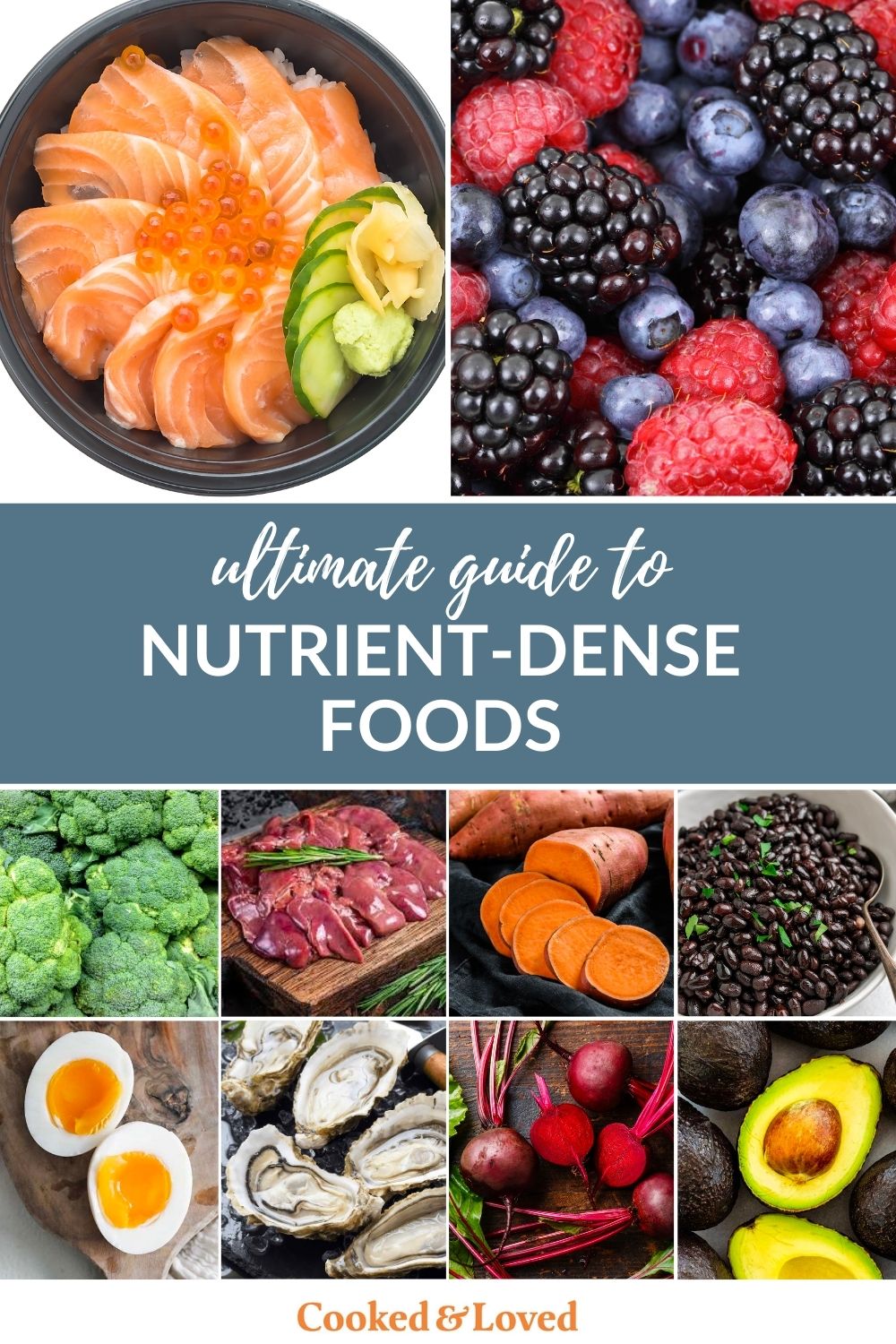Top 50 Nutrient-Dense Foods
In this article, I explore the concept of nutrient density in foods and how to consider the most nutritious ones for your meals. As a qualified nutrition advisor, this is a list I provide to clients, friends and family. I hope you find this list of most nutrient-dense foods useful and insightful.
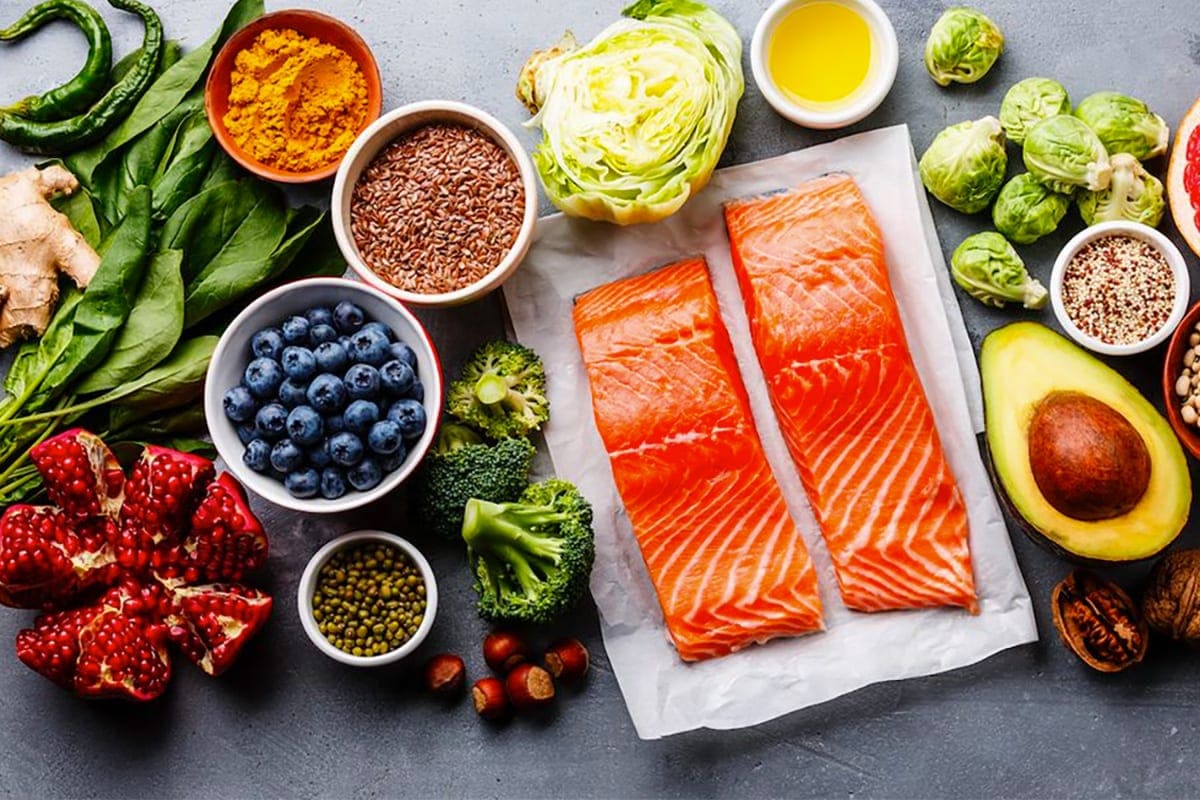
Check out my guide to protein: What It Is & How Much Do You Need?
What Is Nutrient-Density In Foods?
Technically, nutrient density is like a per capita measurement. You’re looking at the number of nutrients – vitamins, minerals, protein, fibre, or whatever it is – in proportion to the calories. It’s kind of switching to the mentality of making every meal really count.
It also contributes to the abundance mindset that may foster some staying power when making changes to your diet. What can you add versus what do you have to take out?
Let’s look at a quick comparison to make nutrient-density quite obvious.
A serving of Little Debbie Swiss Rolls has 270 calories, 2 grams of protein, 4% of the daily recommended value for iron intake, and nothing else notable. On the flip side, a large free-range egg contains 75 calories and 6.3 grams of protein in addition to B vitamins, vitamin D, and plenty of other minerals. Can you tell which food is nutrient-dense?
Nutrient density in foods serves two primary purposes:
- Meeting macronutrient (fat, protein, and carbohydrate) needs without overeating calories. Eating nutrient-dense foods is important because imagine meeting your calorie needs with snack cakes alone. You’d have six or seven, meet virtually none of your nutritional needs, and still be hungry while technically having had enough energy intake for the day.
- Avoiding vitamin and mineral deficiencies. Many nutrient-dense foods boast an impressive amount of vitamins and minerals in small amounts. Berries, seeds, and greens are great examples of this. By adding in these foods and a variety of them, we can eliminate the need for supplementation and reduce risk of deficiencies in the diet.
How To Build A Nutrient-Dense Meal
When it comes to eating healthier, focusing on using nutrient-dense foods and ingredients to make your meals is a pretty simple way to do it.
While there are standout nutritional powerhouses like sardines, oysters, red meat, liver, watercress or kale, not every food on the plate needs to be a superfood!
- First of all, you want to make sure that your meal has high-protein foods, whether they are from animal or plant-based sources. Protein is an essential macronutrient and will keep you satiated. If you can choose a protein source that is also high in vitamins, minerals and healthy fats, then you’re choosing a nutrient-dense protein.
- Add some useful carbohydrates like quinoa, sweet potato or white potato, rice or good quality pasta or sourdough bread. When I say useful, I mean that you’re getting more than just the carbs and sugar from the food. Think about what vitamins or antioxidants it might contain, does it also provide fibre, or maybe it contains complementary amino acids (see our article on Protein 101)
- Throw in some fibre in the form of vegetables or fruit, most of which are high in vitamins and antioxidants so you’ll be upping the nutrient density of that meal right then and there.
- Some healthy fats will complete the circle. This could be from any of the above foods or added in the form of cooking fats or oils, avocado, nuts and seeds.
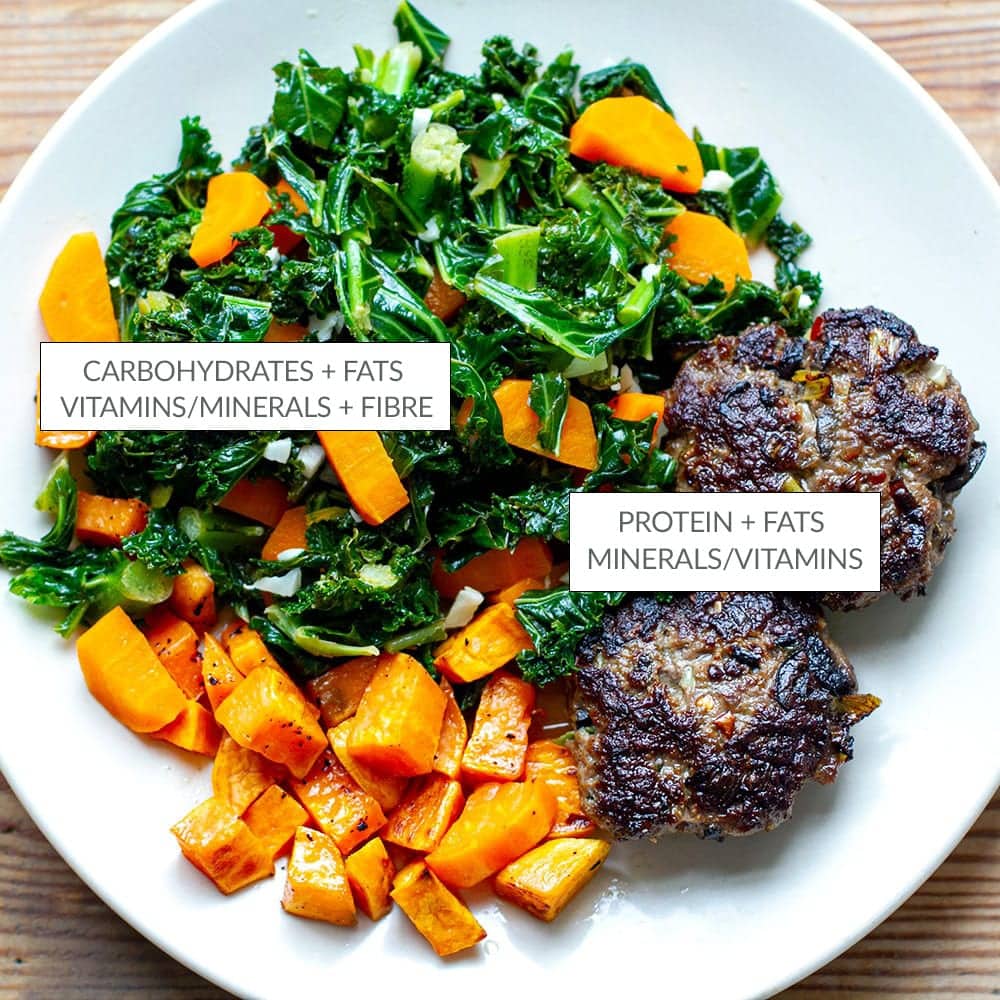
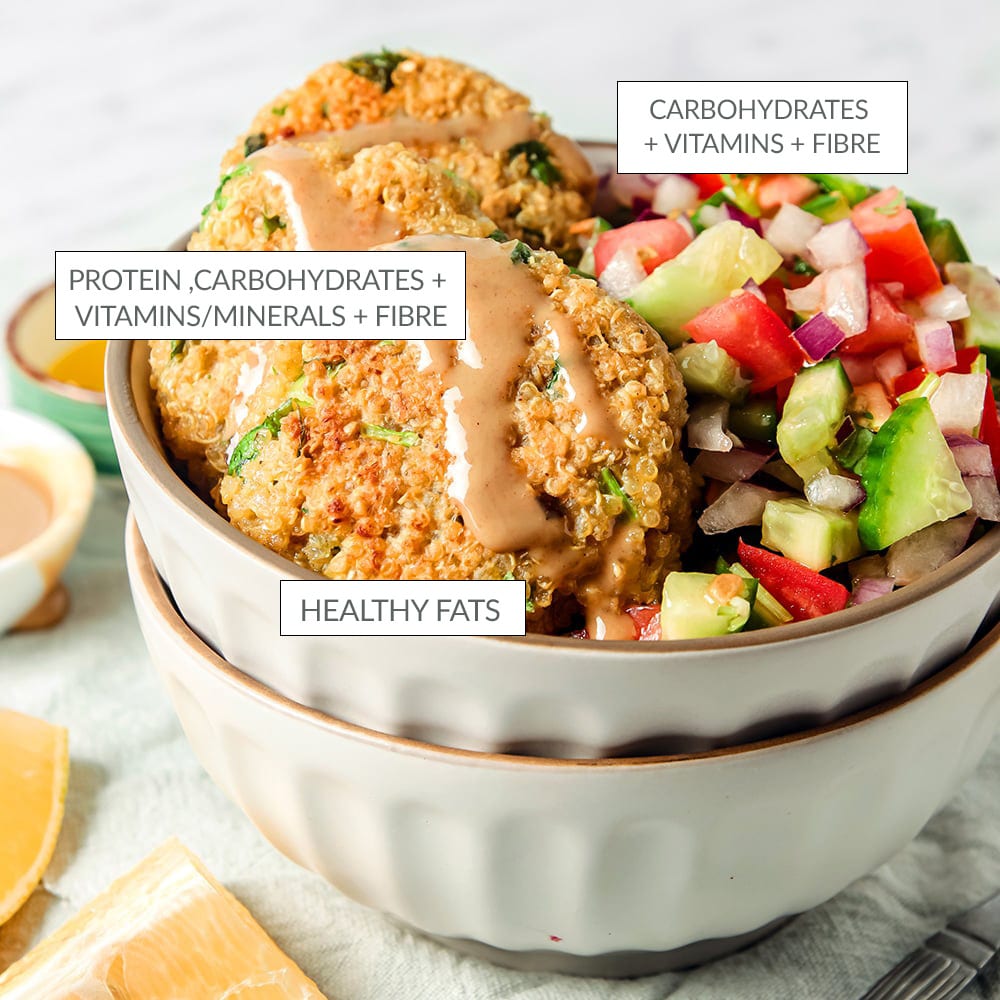
Get the recipe here.
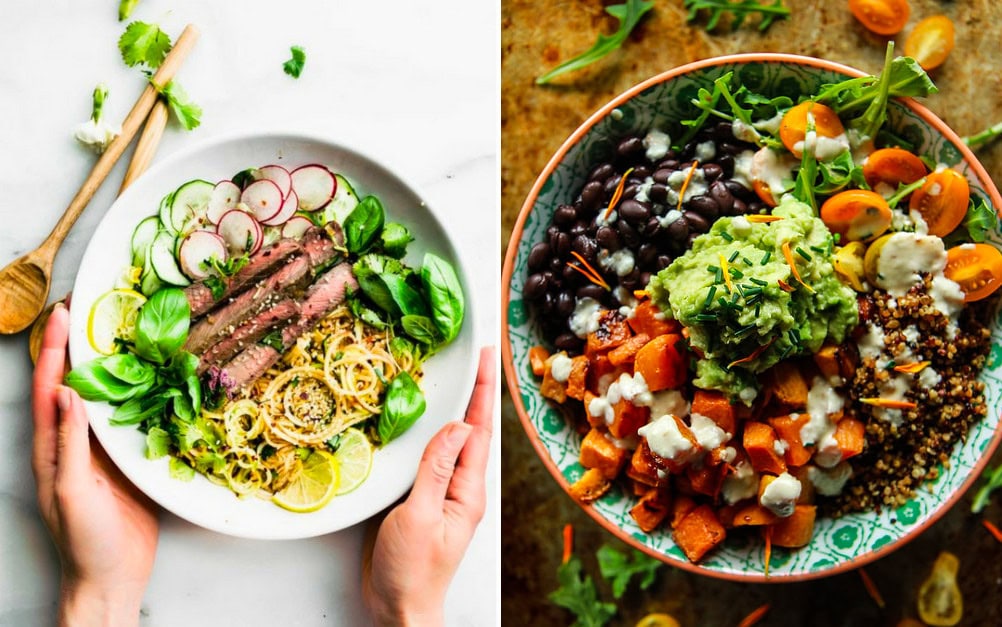
Top 50 Nutrient-Dense Foods
I have put together a list of the 50 most nutritious foods, which you can use as a quick reference. Try to incorporate a few or more into your meals each day with some smart planning and conscious snacking.
Nutrient-dense foods will mainly be of two categories: animal protein and plant foods. Unsurprisingly, whole foods are the most nutritious and packed with vitamins, minerals, and protein.
Each vitamin, antioxidant, fatty acid, amino acid, enzyme, and mineral has certain effects on bodily functions and are linked to a variety of health benefits such as reducing the risk of coronary disease and degenerative disease, improving digestion, improving cognitive function, or fighting free radical damage to cells.
This list is focused on simplicity. While you could divide up each cruciferous vegetable into its own rank (or seed or organ meat), many foods of the same family provide nearly the same benefits. For example, pairing broccoli with kale is less beneficial than pairing broccoli with bell peppers and carrots. Rotating your seeds, greens, cruciferous veggies, and organ meats or other protein throughout the weeks rather than pairing them together will give you the most bang for your buck.
With this list, you’ll be armed to put together powerful plates. Remember: variety is key! You don’t have to eat any one of these foods every single day if you eat a few at most meals.
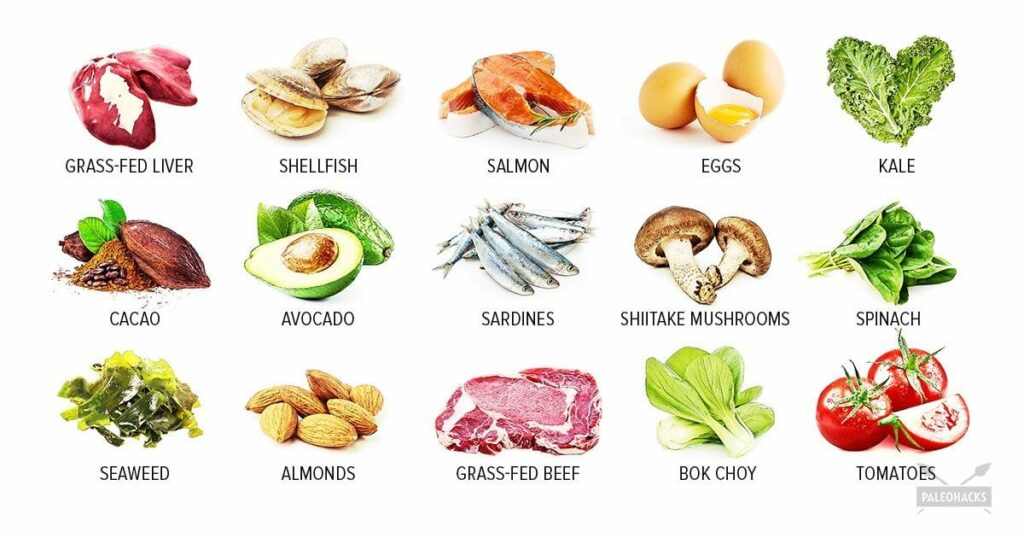
1. Beef Liver
Organ meats are one of the most nutrient-dense foods on the planet, and one that folks are eating less and less of.
While red meat in and of itself provides similar benefits – for example, iron and protein – having a few servings of liver per week is going to keep you high up in the nutritional ranks.
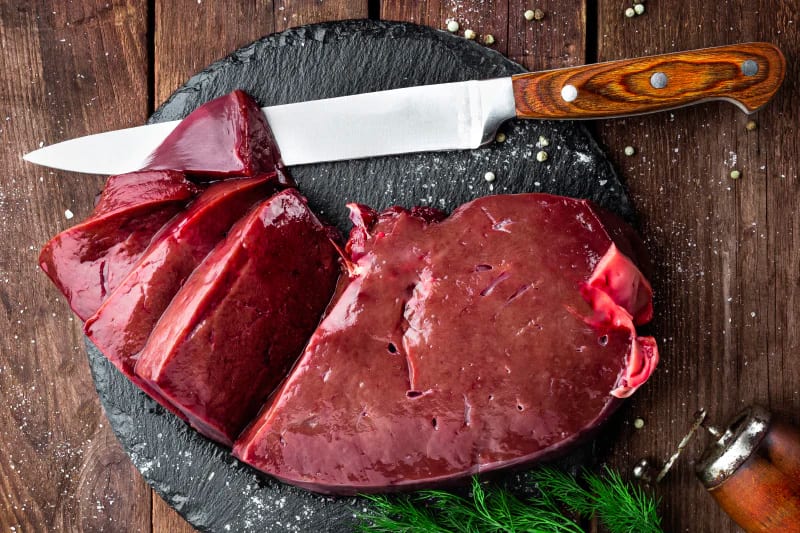
A single serving of beef liver provides more than the daily recommended value of vitamin B12, B2, and vitamin A. Additionally, it provides 65% of your B9, 80% of the RDA for iron, and a substantial amount of copper and choline.
Finally, it’s a very bioavailable source of protein. Many people suffer from iron deficiency and this is one of the most valuable sources of it we can include in our diets. Plus, it acts as a thorough B-complex multivitamin which is arguably one of the most important.
Can’t do liver? Start out with chicken liver which is smaller and has a milder flavour. It’s also more widely available in the stores.
- Ways to eat: Grilled or pan-fried (make sure to not overcook) with strong flavours like onions, garlic and spices. Liver likes sweet foods and sauces too.
- Recipe: Asian Chicken Livers With Onions (can be made with beef liver)
- Recipe: Liver Skewers With Balsamic Onions & Chard
- 10 Liver Recipes To Boost Your Nutrition
2. Beef Kidney
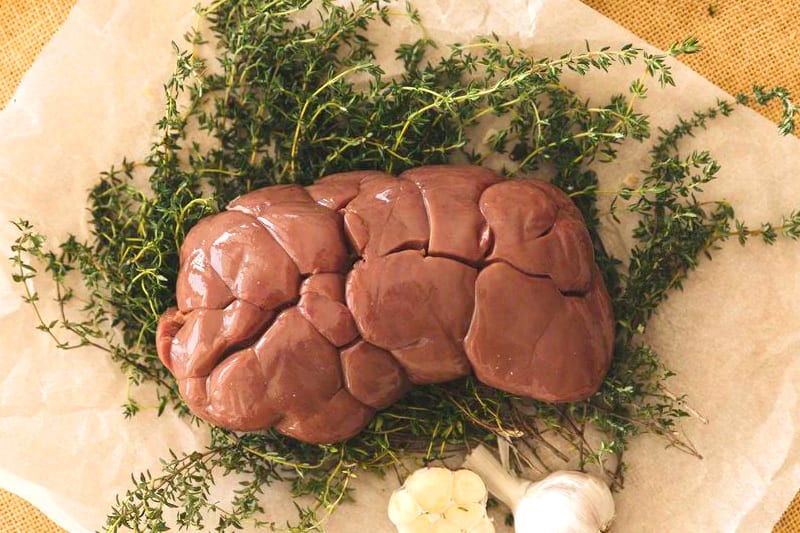
You can count on any organ meat topping the list for nutrient-density. Beef kidney isn’t quite as common as liver, but it’s similarly nutritious coming in right behind liver. One serving gives you 1,146% of the RDA for vitamin B12, 168% of the RDA for riboflavin, 202% of the RDA for selenium, and around half the RDA for iron, vitamin B6, and vitamin A. Again, eating nose to tail has major benefits!
- Ways to eat: braised or stewed, chopped and added to Bolognese sauce or meatballs, pan-freid or grilled on skewers.
- Recipe: Devilled Kidneys
3. Sardines
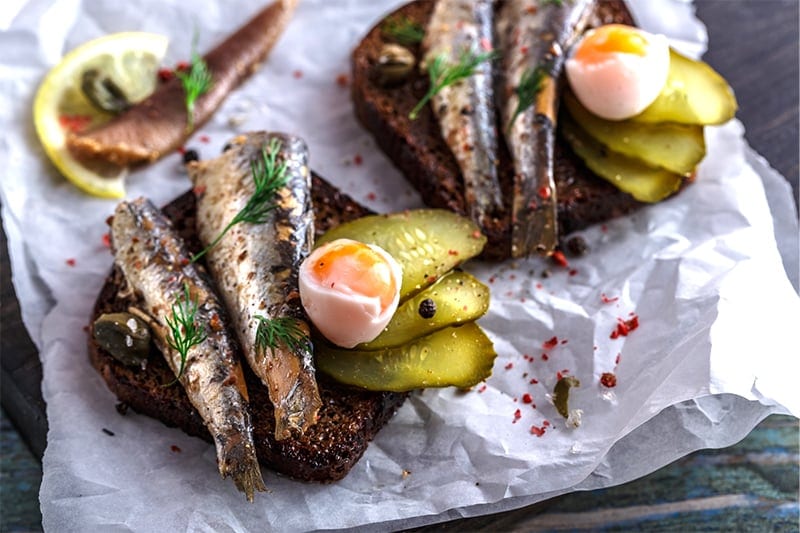
Funnily enough, another budget-friendly option tops the list for nutrient-density!
Sardines can easily be found in tins on the grocery store shelves making it easy to stock up your pantry and get your vitamins and protein on the go. A serving of sardines provides protein and heart-healthy omega-3 fatty acids.
Moreover, you can pack in both vitamin B12 and vitamin D which are two common deficiencies in adults. They’re also loaded with calcium which makes them an especially good choice for those who don’t tolerate dairy well.
- Read More: How To Eat Sardines & Why You Should Start Today
- Recipe: Tasty Sardine Pate (Even For Fussy Eaters)
- Recipe: Sardine Fishcakes With Garlic Aioli & Green Salad
- Recipe: Nicoise Salad With Sardines & Sun-Dried Tomato Dressing
4. Eggs
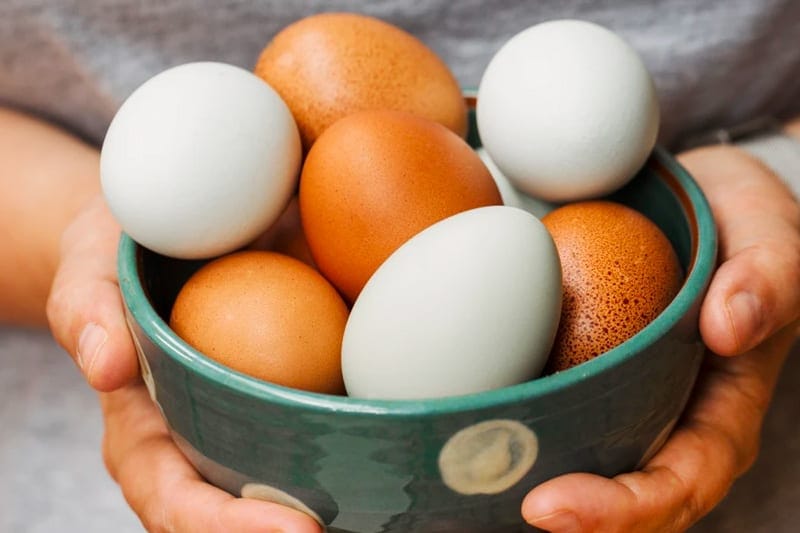
The yolks from healthy, pasture-raised chicken eggs cannot be underestimated.
Of course, people have been eating eggs for years as a hearty source of protein, fat, and overall nutrients. There was a scare at some point due to their cholesterol content, but there are plenty of benefits to be reaped from foods with dietary fat.
A single egg is packed with vitamin A, folate, vitamin B5, vitamin B12, vitamin B2, phosphorus, selenium, protein, and omega-3s. In a two-egg omelette, you can ensure 12-50% of the RDA for all of those vitamins and minerals.
- Ways to eat: Any way you like eggs but you can also add them to fried rice, soups, pancakes etc.
- Recipe: Eggs On Toast With Feta & Tomatoes
- Recipe: Chorizo & Eggs Breakfast Tacos
- Recipe: Spanish Tortilla Egg Muffins (Mini Potato Frittatas)
5. Seaweed varieties
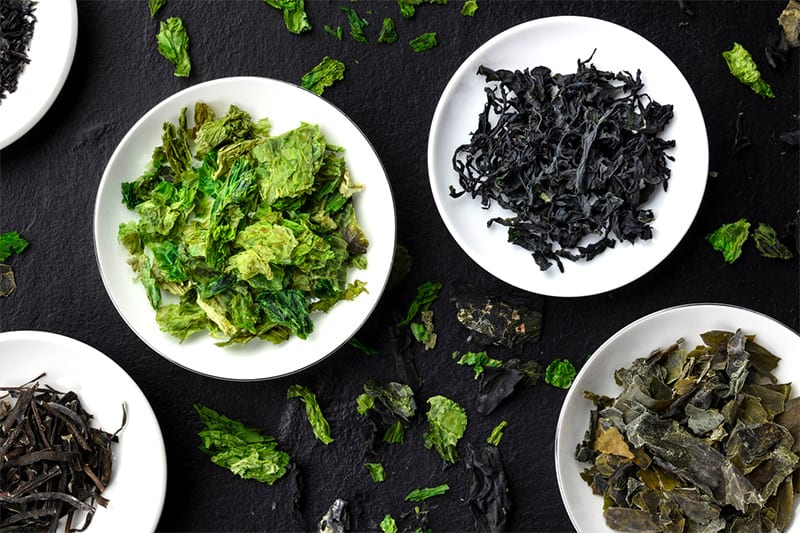
Most seaweed varieties are nutrient-dense and similar in their vitamin and mineral composition. There are countless varieties of algaes and sea plants, but the most common edible types include nori (like in sushi rolls), kombu, dulse (a good seasoning substitute for salt), furikake (another good umami seasoning), kelp, wakame, and chlorella (often found as a supplemental powder).
Seaweed is nutrient-dense, but the serving size is often limited as we typically don’t eat an entire cup of seaweed in one sitting. Even gram for gram, it packs a punch. It’s rich in folate, riboflavin, thiamin, copper, iron, and magnesium. Its B-vitamin load paired with iron makes it nutritionally comparable to red meat (minus the protein). It’s an easy condiment to add to nearly any meal for a boost.
- Ways to eat: Use as a topping on a salad, make sushi, toss into stews and soups.
- Recipe: Rainbow Salad Power Bowl With Salmon & Sesame Dressing
6. Leafy Greens
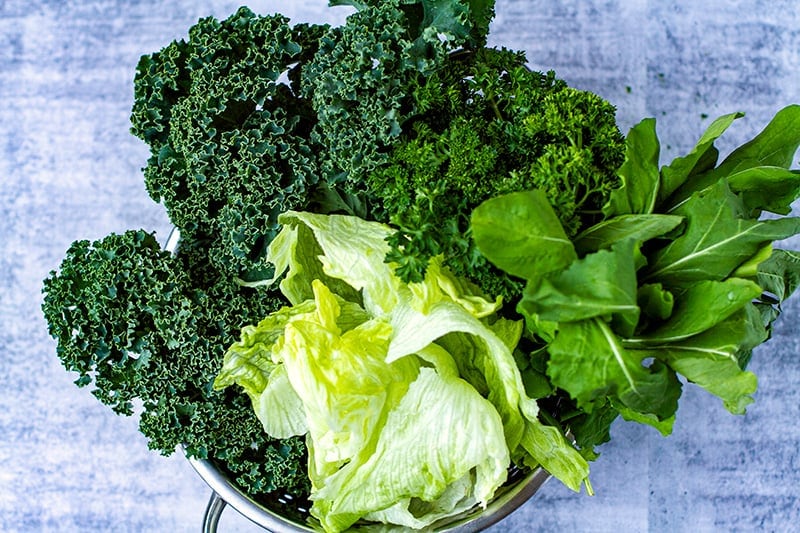
Unsurprisingly, good old leafy greens (kale, collards, spinach) are a classic when it comes to healthy eating. I highly recommend cycling greens as each green has a slightly different makeup in its vitamin and mineral content. With that said, the most nutrient-dense greens are the big, hearty ones: kale, chard, and collards, as well as the more delicate watercress, which is a nutritional powerhouse.
Beetroot greens fall into this category too. Spinach and arugula also pack quite the punch. Compared to less nutrient-dense iceberg lettuce and romaine, the more colourful greens often have the most benefits.
Salad greens are notably high in vitamins A, E, C, and K in addition to being antioxidant-rich. Dark leafy greens are also high in folate which is a B vitamin. They even contain some iron plus essential minerals like calcium, magnesium, and potassium. Eating enough greens and placing emphasis on variety is a surefire way to hit all your micronutrient needs.
- Ways to eat: Leafy greens can be eaten raw and cooked, so it’s anything from salads to soups, stews and smoothies.
- Recipe: Cheesy Leafy Green Salad (Low-Carb, Keto, Gluten-Free)
- Recipe: Turkey Meatballs & Kale In Lemony Garlic Broth (Paleo, Whole30)
- Read more: 101 Guide To Asian Greens & Vegetables
- Recipe: Watercress Salad With Avocado, Orange & Chia Seeds (Paleo, Vegan)
7. Goji & Acai Berries
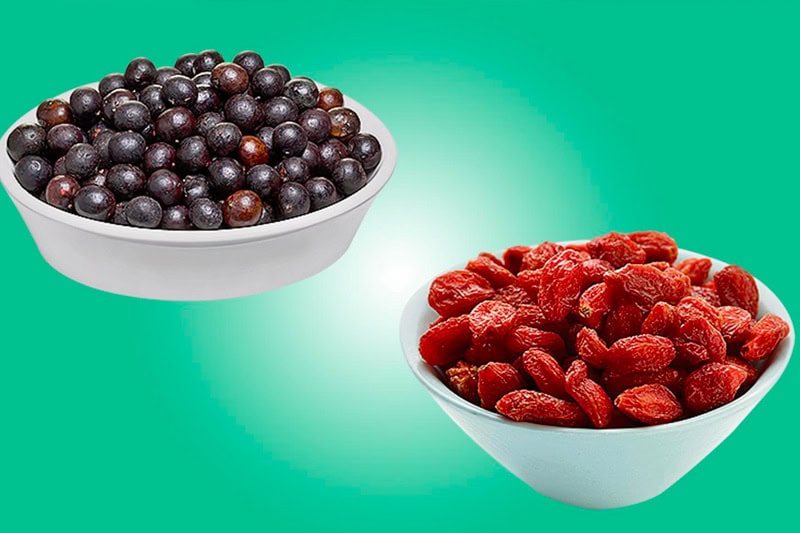
Exotic berries and berry powders are often sold at high prices in health food stores. In the past decade, they’ve gained a lot of traction as superfoods and they absolutely are. With the high price tag, it’s important to remember that nutrient-density means bang for your buck. Acai packets are often sold in the freezer section and can be added to smoothies for a boost, while goji berries can be sprinkled on top of oatmeal to up your antioxidant intake. These foods are not essential, but gram for gram, they’re a nutritional force to be reckoned with.
An ounce of goji berries provides you with 11% of your RDA for iron and 15% of your RDA for vitamin C. Acai is loaded with vitamin A and trace minerals. Both berries are rich in antioxidants making them a solid cancer-fighting food, good for your skin, and more. Like with greens, these berries are easy to identify as a superfood due to their rich, deep colours.
- Recipe: Vanilla Goji Berry Balls
- Recipe: Acai Berry Smoothie
8. Bone Broth
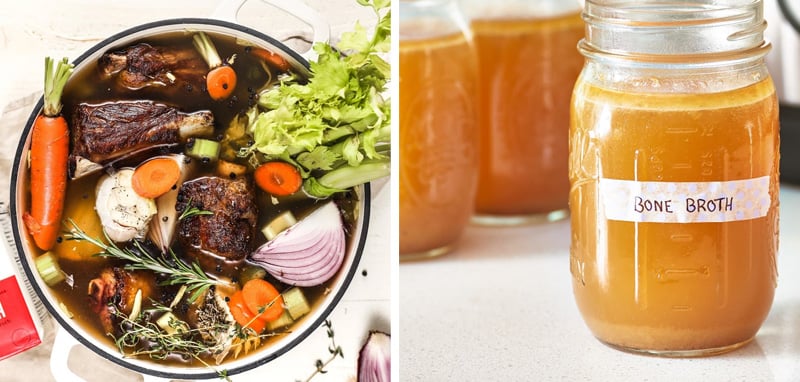
Bone broth is a staple in the ancestral diet and contains many health benefits that your average stock doesn’t. Plus, it’s easy to make and resourceful with a focus on using the entirety of an animal’s parts. It’s simple to make using bones and connective tissue from any animal, boiling it down to flavour broth.
The bones of an animal contain a different nutrient makeup than the muscle meat, similar to the organ meats. This makes bone broth abundant with minerals such as calcium, magnesium, potassium, and phosphorus. Fish bones contain iodine while cartilage tissues provide glucosamine and chondroitin which support healthy joints. As a rule, the animal part being used supports the same parts in the human body.
A good bone broth will gelatinise when cooled and settled. This is because the final product is rich in collagen which is an excellent source of protein with benefits for gut health, skin, hair, nails, and essential amino acid intake.
- Read more: 15 Ideas For How To Use Bone Broth
- Recipe: How To Make Nutritious Beef Bone Broth
- Recipe: Instant Pot Chicken Bone Broth
9. Berries
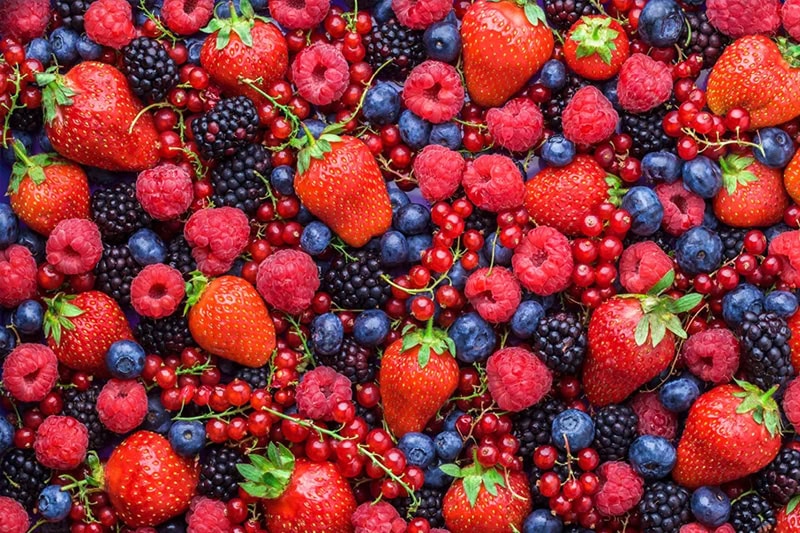
Berries (blackberries, raspberries, blueberries, etc.) are one of the most antioxidant-rich fruits which is mostly where they get their superfood status from.
Ultimately, antioxidants protect the cells against damage from free radicals which may reduce risk of cancer, neurodegenerative diseases, and more. They’re all a good source of fibre, low in sugar which may improve blood sugar markers, and high in vitamin C, manganese, vitamin K1, copper, and folate.
10. Wild Caught Salmon
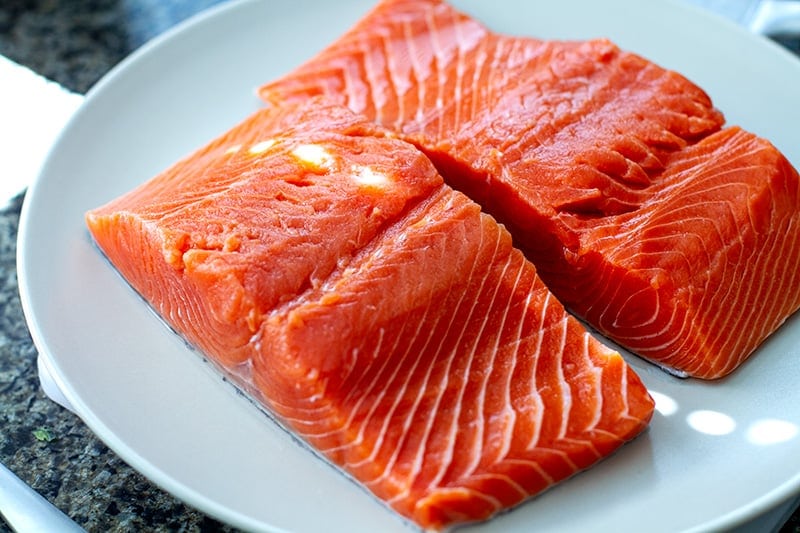
Between wild caught salmon and farmed salmon, the main difference is in how much of the nutrient profile you’re getting. There is a clear winner with wild caught, though. A serving of salmon provides you with over 100% of the RDA for vitamin B12 plus substantial amounts of B6, selenium, niacin, thiamine, phosphorus, and pantothenic acid. It’s also rich in omega-3 fatty acids and of course, protein.
Generally speaking, fatty fish is a nutrient-dense food and salmon is a clear winner. If you can’t afford fresh salmon, go for frozen or canned stuff, it’s just as good.
- Recipe: Salmon Bites With Sticky Sweet Chili Soy Glaze
- Recipe: Mediterranean Baked Salmon Fillets In 30 Minutes
- Recipe: Salmon Fish Cakes With Sweet Potatoes & Peas
11. Grass-Fed Beef
Grass-fed beef is superior to corn or grain-fed beef when it comes to nutrient density. In fact, the difference can be quite substantial.
Most notably, grass-fed beef contains far more omega-3 fatty acids whereas conventional beef will contain more omega-6 fatty acids. While we need both, the “standard American diet” often puts us at a high ratio of omega-6’s to omega-3 (and we want the opposite).
Additionally, it’s high in iron, vitamin B3, vitamin B6, choline, phosphorus, and selenium. Choose grass-fed when possible, but all beef is a good source of these vitamins and of course, an excellent source of protein. Finally, it’s worth noting that grass-fed is not an FDA-regulated term, so it can be hard to source effectively.
- Recipe: Grilled Onion Cheddar Burgers & Coleslaw
- Recipe: Homemade Beef Burgers With Garlic Kale & Sweet Potatoes
- Recipe: Beef Cheeks Slow-Cooked With Port & Vanilla
12. Cruciferous Vegetables
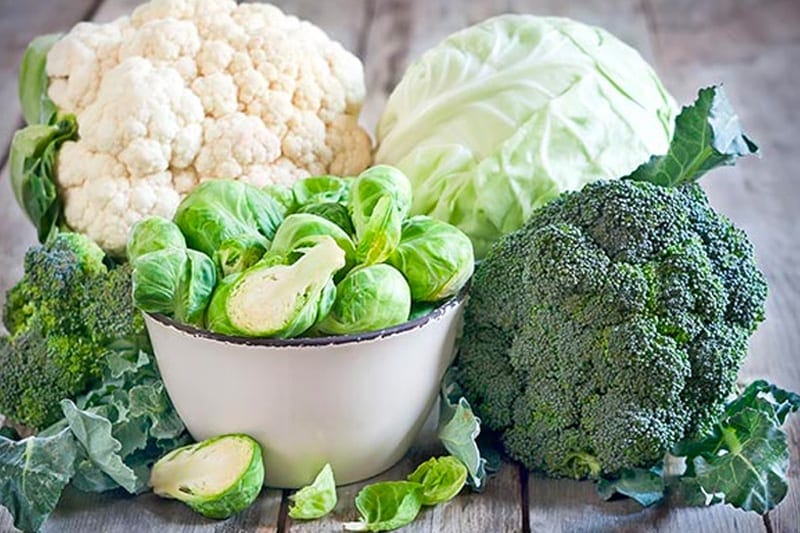
Think broccoli, kale, cauliflower, cabbage, Brussels sprouts. While all of these veggies look a little different from one another, they are all from the same family which means they’re rather similar nutritionally.
Glucosinolates are responsible for the bitter flavour in these veggies and also the source of their antioxidant and anti-inflammatory properties. Each veggie is also fibrous and rich in vitamin C, folic acid, iron, calcium, and selenium. Raw intake of cruciferous vegetables can be a lot for digestion, and the nutrients in these foods are best absorbed when lightly cooked.
- Recipe: Red Cabbage Coleslaw With Apple & Parmesan
- Recipe: Cabbage Pie
- Recipe: Easy Chicken & Broccoli Stir-Fry (Low-Carb, Keto)
- Recipe: Honey Balsamic Roasted Brussels Sprouts (seriously, the BEST!)
- Recipe: Quick Sauerkraut Recipe (Step-By-Step Photos)
- Recipe: Pan-Fried Broccoli With Garlic
13. Sweet potato
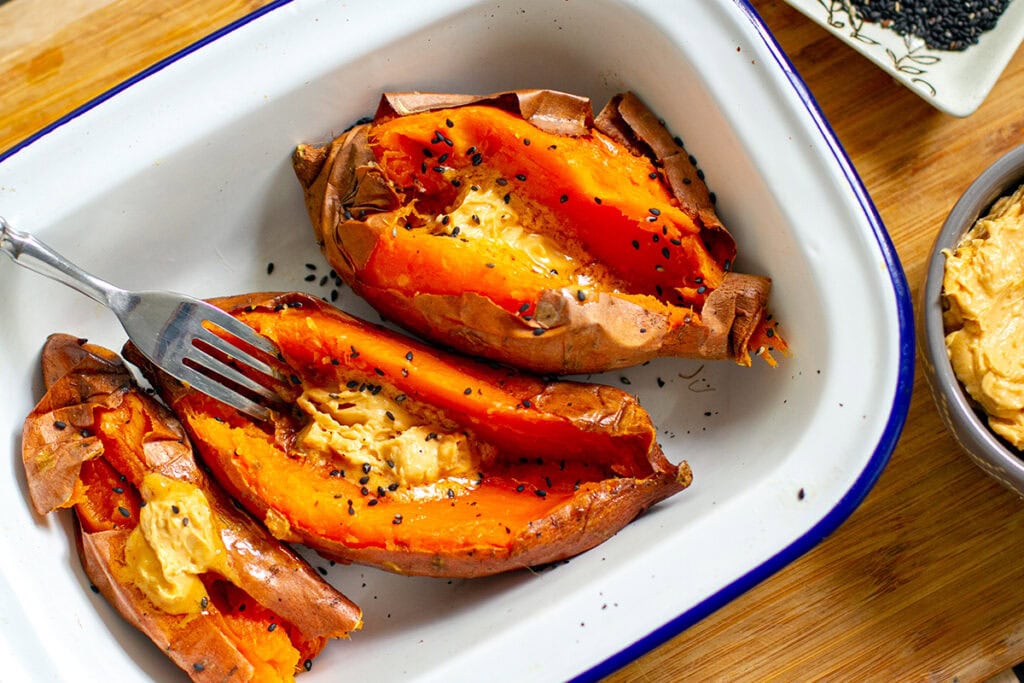
Starchy orange root vegetables like sweet potatoes and pumpkin have a similar nutrient makeup, so other winter squash varieties are rather nutrient-dense as well.
For example, butternut squash, kabocha squash, acorn squash, and delicata squash. Sweet potato is a good alternative to regular potato. While both are high in fibre and provide whole food carbohydrate energy, sweet potatoes are loaded with nutrients making them an optimal starchy multivitamin.
You can get 213% of the RDA for vitamin A in a single serving in addition to vitamin C, manganese, copper, pantothenic acid, vitamin B6, potassium, and niacin. They also contain both soluble and insoluble fibre and are rich with antioxidants.
- Recipe: Sweet Potato Salad With Pickled Onions & Coriander
- Recipe: Stuffed Sweet Potatoes With Spanish Tuna & Peppers
- Recipe: Roasted Sweet Potatoes With Walnut Parsley & Garlic
14. Garlic
Garlic is an easy nutrient-dense staple food that you’re probably already using. It’s long been used as a folk remedy for various illnesses and ailments – probably because of its rich antioxidant profile. Garlic is also rich in manganese, vitamin B6, vitamin C, and selenium.
- Recipe: Whipped Feta With Roasted Tomatoes & Garlic
- Recipe: Honey Lemon Garlic Pepper Chicken Thighs
- Recipe: Garlic Chicken Soup (Quick & Easy Recipe)
15. Beetroot
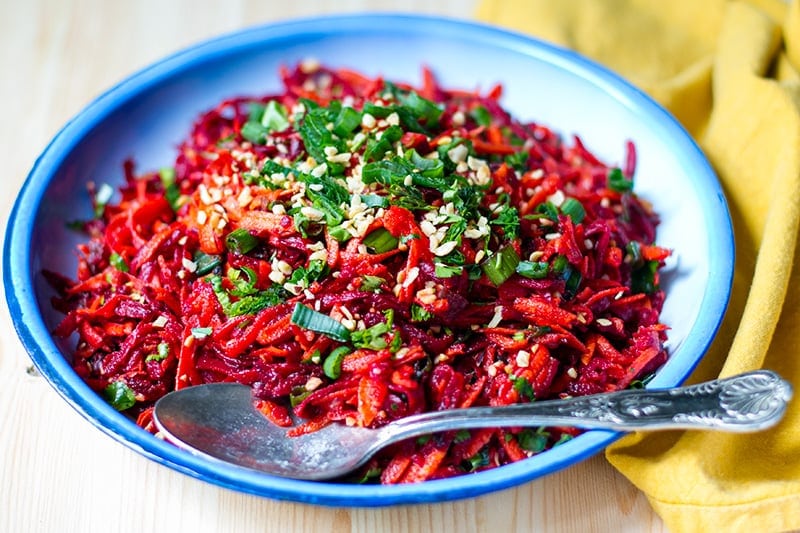
Beets are another vibrant food that gives away its superfood status with just one look. The beet greens are worth saving as they are leafy and chock full of nutrients, so don’t be so quick to toss them. The root itself is also quite nutrient-dense. A 100-gram serving contains 20% of the RDA for folate in addition to notable amounts of B6, vitamin C, magnesium, copper, manganese, potassium, and iron.
- Recipe: Fermented Beets & Cauliflower With Garlic & Dill
- Recipe: Moroccan Carrot & Beetroot Salad
- Recipe: Roasted Beets With Shallot & Mustard Vinaigrette
- Recipe: Borscht Soup (Vegetarian, Gluten-free, Paleo)
16. Coconut
Coconut is primarily composed of dietary fat, but most markedly, they contain medium-chain triglycerides. Coconut oil is an efficient means of reaping the nutritional benefits of this tree nut. MCT is thought to have metabolic benefits which can improve weight loss and management. They’re also a rapid energy supply delivered straight to the liver for use unlike short- and long-chain triglycerides.
- Recipe: The BEST Coconut Cauliflower Rice
- Recipe: Coconut Yoghurt Panna Cotta (Dairy-Free, Low-Carb)
- Recipe: Coconut Yoghurt Chicken
17. Green Herbs
Many nutrient-dense foods are easily added to any meal, regardless of your flavour preferences. Herbs such as parsley, basil, coriander/cilantro and so on pack a punch despite being consumed in relatively small quantities. Pesto, anyone?
Fresh herbs contain vitamins A, E, and K in addition to polyphenols which make them high in antioxidants.
- Recipe: Homemade Paleo Basil Pesto (Dairy-Free)
- Recipe: Easy Garlic & Parsley Grilled Cod
- Recipe: Carrot & Coriander Slaw Salad
18. Roe

Roe or fish eggs aren’t the most common food, but if you eat sushi, you’ve probably had it. A single ounce of roe contains 100% of the RDA for vitamin B12, 55% of your RDA for cobalamin – a B complex vitamin – in addition to 8 grams of protein, choline, some vitamin C, and vitamin B6.
- Recipe: Homemade Salmon Caviar
- Recipe: Buckwheat Blinis With Salmon Roe Caviar
19. Oysters
Most seafood is jam-packed with the essentials. Oysters are a delectable indulgence worth partaking in. Six oysters give you a hefty dose of iron, 230% of the RDA for cobalamin, calcium, magnesium, vitamin C, and vitamin B6.
Recipe: Oysters with Zesty Vietnamese Dressing
20. Anchovies
Give your pizza an upgrade with a can of anchovies. These tiny treasures of the sea pack in iron, calcium, magnesium, selenium, vitamin B3, and vitamin D. Moreover, they’re high in omega-3 fatty acids.
Anchovies are great for adding saltiness and umami flavour to dishes (e.g. Caesar salad dressing) so you can use them quite creatively.
Ways to eat: Anchovies on buttered toast or with crackers and roasted red peppers, add them to pasta, and Caesar salad, to meet stews for extra umami flavour.
21. Lamb
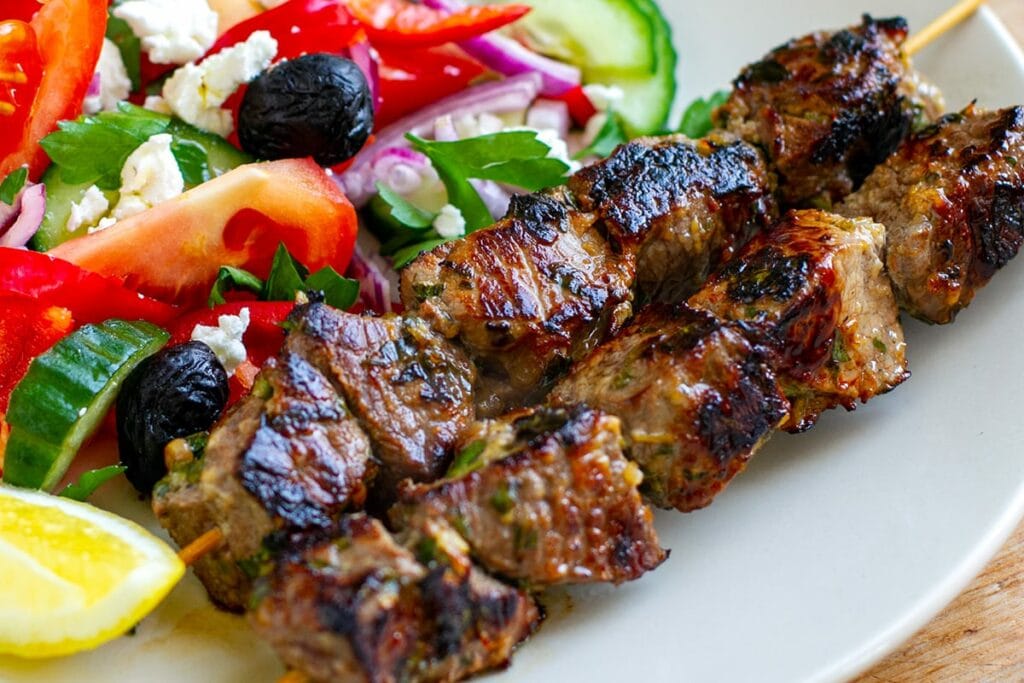
Like beef, sourcing grass-fed lamb makes a difference in the omega fatty acids makeup of the food. Conventional or grass-fed lamb is a good source of iron, zinc, and vitamin B12.
- Recipe: Coconut Lamb Curry (Paleo, Whole30)
- Recipe: Slow-Cooked Lamb Shoulder With Rosemary Garlic & Honey
- Recipe: Spiced Pan-Fried Lamb Chops With Mint Vinaigrette
- Recipe: Lamb Burgers With Feta & Black Olives + Grilled Zucchini
- Recipe: Lamb Kabobs Souvlaki With Greek Salad
22. Pork belly
Pork belly is extremely fatty which may convince some people it’s not very healthy, but the source is key. Pastured pork contains considerably more selenium and vitamin B. Pork belly is also rich in B complex vitamins and heart-healthy monounsaturated fats. In general, all cuts of pastured pork are very nutrient-dense.
Recipe: Chinese Crispy Pork Belly
23. Black Beans
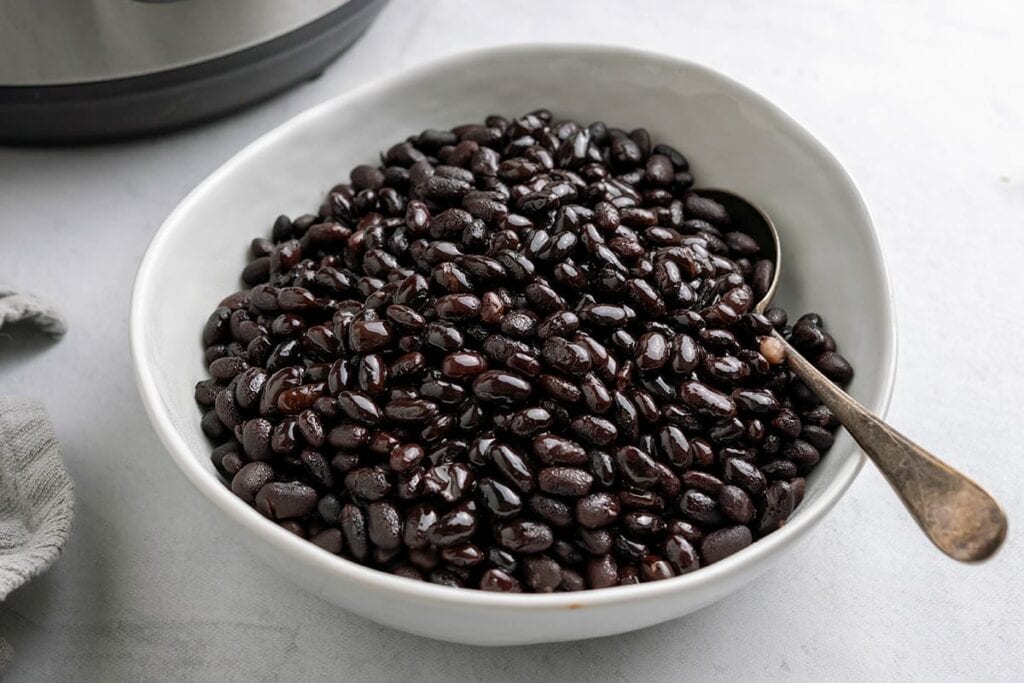
Many nutrient-dense foods are animal-based protein sources, but black beans are here to speak for the plant-based protein sources! They’re low in fat and high in fibre making them heart-healthy and good for digestion – especially when soaked prior to cooking. They’re also rich in iron, thiamin, and folate.
- Recipe: The BEST Black Bean Burgers
- Recipe: Easy Black Bean Soup
24. Yoghurt
Yoghurt is an outstanding choice for anyone with a host of benefits. First and foremost, it’s an excellent source of protein – especially Greek yoghurt. It’s also packed with probiotics which provide healthy bacteria for the gut. On top of that, it’s packed with calcium for strong bones, vitamin B12, phosphorus, magnesium, potassium, and is often fortified with vitamin D.
25. Avocado
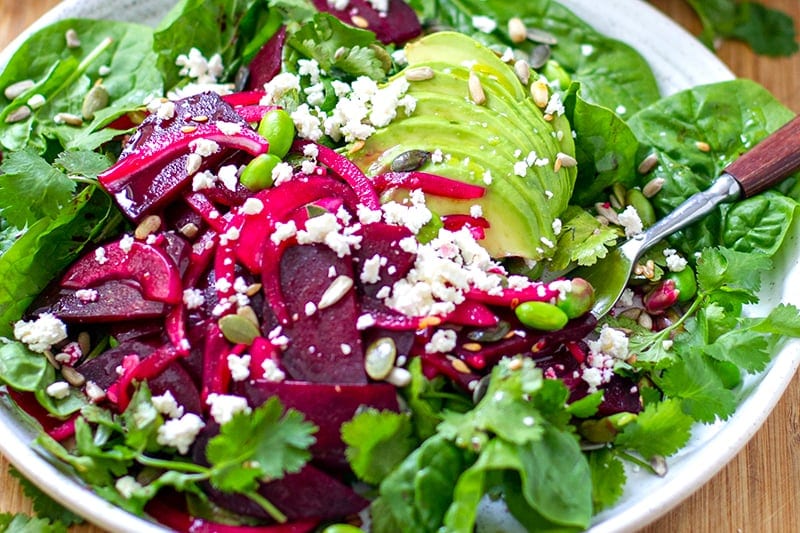
Avocado is most well-known for its healthy fat content (the kind that works in your cholesterol level’s favour), but it’s also high in many vitamins and minerals including vitamin K, vitamin E, vitamin C, several B vitamins, folate, magnesium, copper, and potassium.
- Recipe: Avocado Halloumi Salad With Mediterranean Dressing
- Recipe: Beetroot, Avocado & Edamame Salad
- Recipe: 15 Best Stuffed Avocado Recipes
26. Spirulina
Spirulina is a powder sourced from algae, but it’s not typically sorted amongst seaweeds. It does, however, have many similar benefits. It’s commonly found in powder form in the bulk section or at a health foods store, and it’s easy to add to smoothies with a relatively mild flavour. It’s a complete plant protein and contains B vitamins such as thiamin, riboflavin, and niacin as well as copper and iron.
27. Mushrooms
Mushrooms come in all different varieties, but they all boast a serious nutrient lineup with a high amount of dietary fibre, B vitamins, copper, and potassium. They’re also rich in the antioxidant selenium.
28. Artichokes
Artichokes are an easy food to add to the diet considering you can add canned artichokes to homemade pizzas or salads with ease. They’re packed with fibre, folate, and vitamins C and K in addition to magnesium, potassium, and iron.
29. Tomatoes
These colourful fruits are loaded with nutrients, but most importantly, tomatoes earn their nutrient-density from lycopene – an antioxidant. They’re also rich in vitamin C, vitamin K, potassium, and folate.
- Recipe: Mozzarella Salad With Balsamic Tomatoes
- Recipe: Roasted Cherry Tomato Soup With Creamy Mascarpone
- Recipe: Tomato Ricotta Salad With Gremolata
30. Green Beans
Green beans are an underrated source of vitamin C, packing in 27% of the RDA in a single cup. They’re also high in iron, vitamin B6, magnesium, and calcium.
31. Carrots
The orange colour in carrots is due to their claim to fame as a superfood a.k.a. Beta-carotene. This is an antioxidant that the body converts to vitamin A. Carrots are also abundant in fibre, vitamin K1, and potassium.
32. Capsicum/Bell Peppers
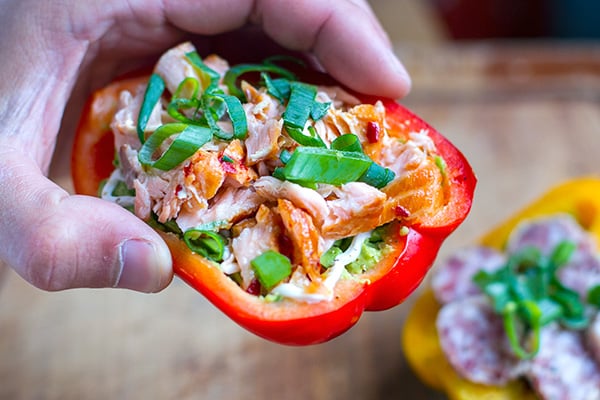
Bell peppers are akin to oranges in the vitamin C department. Sweet bell peppers are especially nutritious so choose the warm-coloured varieties to reap the most benefits. A single bell pepper boasts 253% of the RDA for vitamin C as well as vitamin B6, vitamin K1, potassium, folate, vitamin E, and beta-carotene (or vitamin A!).
Recipe: Quinoa Stuffed Peppers (Gluten-free)
33. Raw Cacao
Raw cacao is a powder with a rich chocolate flavour without the sweetness. Its most notable benefit is flavanols – a powerful antioxidant. One particular flavanol – epicatechin – is thought to boost brain function. It also contains magnesium, iron, calcium, potassium, and phosphorus.
34. Pumpkin Seeds
A single ounce of pepitas – the shelled, green pumpkin seeds – contains a host of nutrients such as 30-40% of the RDA for magnesium, phosphorus , and manganese. They also have a good deal of iron, zinc, copper, and vitamin K. Plus, they’re chock full of healthy fats.
35. Chia Seeds
Chia seeds are another example of a true superfood. You can get a surprising amount of nutrient-density from a single serving of two tablespoons including 12-25% of the RDA for iron, fibre, calcium, magnesium, phosphorus, zinc, vitamin B1, vitamin B3, and omega-3 fatty acids.
36. Raw Cheese
While all cheese is a good source of protein, raw cheese is especially nutrient-dense. It can improve digestion with its abundance of digestive enzymes and has a high concentration of conjugated linoleic acid which may be protective against diabetes, cancer, and heart disease.
37. Kefir
Kefir is a fermented dairy drink that contains many of the same benefits as yoghurt. It promotes healthy gut bacteria and boasts notable amounts of protein, calcium, phosphorus, vitamin B12, vitamin B2, magnesium, and vitamin D.
38. Arugula/Rocket
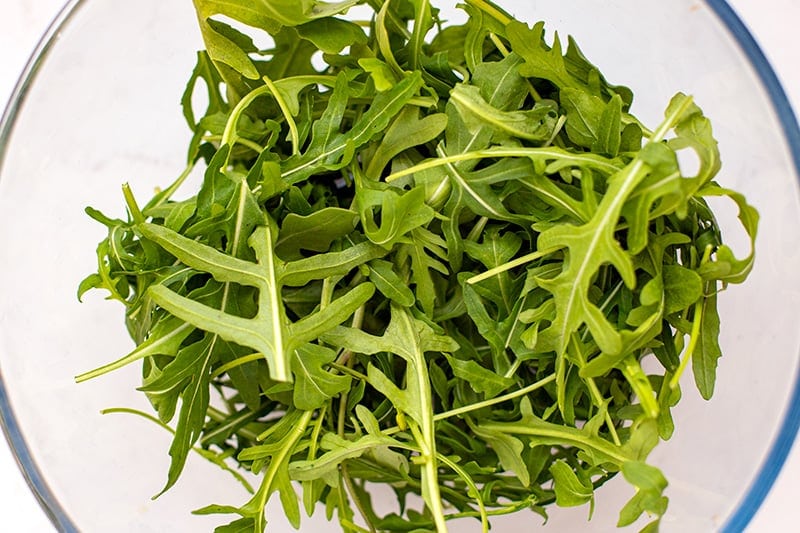
Dark leafy greens are great for your health across the board, but the more delicate salad greens such as arugula stand out as well. It’s rich with antioxidants, calcium, potassium, vitamin C, vitamin A, vitamin K, and folate (a B vitamin).
39. Spring Onions
Spring onions are a tasty garnish for many dishes and well worth adding. They’re fibrous in addition to being rich in vitamin K, vitamin C, and folate.
40. Wild Rice
Rice is a great source of fibre and grain protein to add to the diet, but wild rice is by and large the most nutritious. It contains iron, vitamin B6, and a single cup provides 70% of the RDA for magnesium.
- Recipes: 23 Gorgeous Wild Rice Recipes
41. Lentils
Lentils are a good source of fibre and protein. They’re also high in iron, selenium, and folate. They’re also rich in phenols – an antioxidant – making them anti-inflammatory, anti-viral, and antibacterial.
42. Parsnips
This unsuspecting root veggie is more nutrient-dense than you might know. A single cup serving provides 25% of the RDA for vitamin C, vitamin K, and folate. You’ll also come across some vitamin E, vitamin B6, magnesium, thiamine, phosphorus, and zinc.
- Recipe: Spiced Roasted Parsnips
- Recipe: Parsnip & Cauliflower Mash with Garlic Butter
43. Apples
Apples come into the rank as an easy snack that can add a lot of nutrition to your day. They’re fibrous and watery which make them filling, especially when paired with a fat to help you absorb the vitamins and minerals. They’re high in vitamin C, copper, potassium, and vitamin K.
Recipe: Kale Chicken & Apple Salad
44. Amaranth
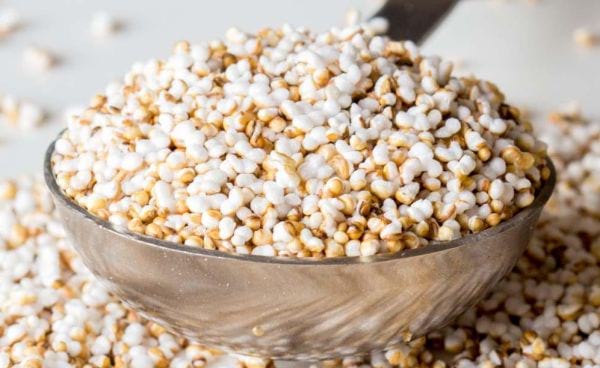
Amaranth is an underrated gluten-free grain rich in antioxidants such as gallic acid and vanillic acid. It also provides 105% of the RDA for manganese, 40% of the RDA for magnesium, 36% of your daily phosphorus needs, and 29% of the iron you need making it a good meat alternative for those who are iron deficient. It also has notable amounts of selenium and copper.
Recipe: Protein Lentils & Amaranth Patties
45. Potatoes
Sweet potatoes are all the hype when it comes to “healthy eating,” but good old white potatoes have a host of nutritional benefits too! Plus, they’re downright delicious. They contain vitamin C, vitamin B6, potassium, manganese, magnesium, phosphorus, niacin, and folate. Plus they’re rich in antioxidant compounds flavonoids, carotenoids, and phenolic acids.
Recipe: Crispy Smashed Potatoes & Salsa Verde Peas
46. Quinoa
Quinoa is unique because it’s a plant food and also a complete protein meaning it contains all the essential amino acids our body doesn’t make on its own. It also contains vitamin C, vitamin K, folate, vitamin E, magnesium, thiamine, and several other minerals. Finally, it contains both soluble and insoluble fibre which promote healthy gut and digestion.
- Recipe: Mediterranean Quinoa Salad With Lemon Basil Dressing
- Recipe: Quinoa Falafels With Israeli Salad
- Recipe: Chicken Quinoa Salad With Honey Harissa & Tahini Yoghurt
- Recipe: Roasted Quinoa Salad With Sweet Potatoes & Brussels Sprouts
47. Tempeh
Tempeh is an excellent source of plant protein made from soy which is a complete protein too. It’s also fermented providing those good gut-healthy bacteria. Tempeh also contains iron, calcium, a good complex of B vitamins, phosphorus, magnesium, and manganese.
Recipe: Tempeh Buddha Bowl
48. Oats
Oats are a filling and highly customisable breakfast option with loads of nutrients. They’re high in minerals such as phosphorus, magnesium, copper, and iron. Plus, they contain B vitamins, fibre to keep you full and promote digestion, and even contain some protein.
49. Walnuts
Walnuts are incredibly antioxidant rich as a result of being high in vitamin E, melatonin, and polyphenols which could reduce cholesterol levels. They’re also tremendously high in omega-3 fatty acids.
- Recipe: Mushroom Cauliflower & Walnut Taco ‘Meat’ (Vegan, Paleo)
- Recipe: Georgian Salad With Creamy Walnut Dressing (Paleo, Vegan)
- Recipe: Roast Pumpkin & Beetroot Salad With Maple Walnuts
50. Brazil Nuts
Brazil nuts are large and hearty – a few are a great way to get in your daily dose of selenium! A single ounce contains 989% of the RDA. They also contain 55% of the RDA for copper in addition to magnesium, phosphorus, manganese, zinc, thiamine, and vitamin E. All nuts are a good source of healthy fats and protein as well.
There are many more nutrient-dense foods worth mentioning like almonds, fruit and various fish and seafood but I will stop at these 50. Some of them are groups or families that include multiple foods, so the list is actually longer.
Next time you start meal planning or go grocery shopping, put a dozen of these foods on your list and I bet you will improve the nutrient density of your meals right away.
Nutrients Glossary
Nutrient-density is measured by micro and macronutrients including vitamins, minerals, protein, fat, and carbohydrates. There are also other considerations when deciding what makes a superfood such as fatty acids, enzymes, and antioxidants.
For example, many nutrients are converted when ingested. Many vitamins rely on other vitamins to work effectively which is why eating foods with a variety and abundance of many is ideal.
The general consensus in the list is that each food packs a LOT into a small bite (or a normal portion of the food on your plate). Here is a quick rundown of what each nutrient brings to the table.
- Vitamin A. Supports healthy vision. Bolsters the immune system. Important for reproduction, growth, and development. Carotenoids are also converted to vitamin A. A common carotenoid is beta-carotene.
- Vitamin B1 (thiamin). Breaks down sugar in the bloodstream. Produces fatty acids. Creates some neurotransmitters.
- Vitamin B2 (riboflavin). Used for energy production. Breaks down fats, drugs, and steroid hormones. Converts tryptophan to vitamin B3. Assists enzymes in daily functions.
- Vitamin B3 (niacin). Converts nutrients to energy. Creates cholesterol and fats. Yields antioxidant effects.
- Vitamin B7 (biotin). Breaks down fats, carbohydrates, and protein. Regulates DNA.
- Vitamin B9 (folate). Needed to produce healthy red blood cells. Essential for metabolising amino acids and vitamins.
- Vitamin B12 (cobalamin). Necessary for forming red blood cells and DNA. Promotes healthy neurological function. Used to metabolise fat and protein.
- Vitamin C. An antioxidant that protects cells against free radical damage. Protects the immune system. Promotes good vision health.
- Vitamin D. Helps the body to retain calcium and phosphorus. Builds and maintains healthy bones. Anti-inflammatory, antioxidant, and neuroprotective.
- Vitamin E. Acts as an antioxidant. Improves immune function. Promotes heart health by preventing clots and clogged arteries.
- Vitamin K1. Assists in blood clotting. Prevents bone loss and fractures.
- Omega-3 fatty acids. Aid in proper cellular function, particularly in the eyes and brain. Raise good cholesterol and reduce blood pressure. May lower risk of heart disease and cancer.
- Digestive enzymes. Aids in the body’s breakdown of macronutrients (fat, protein, carbs). May improve lactose intolerance. Aids in digestion and absorption of nutrients.
- Probiotics. Helps the body to maintain healthy bacteria in the gut. Positively impacts the body’s immune response. May improve symptoms of bowel disorders.
- Antioxidants. Fights free radical damage to cells which provides cancer-fighting properties and, when sourced from food with other nutrients, may prevent heart disease, cognitive decline, and vision loss.
- Copper. Involved in iron metabolism. May reduce blood pressure. Builds red blood cells, collagen, connective tissue, and brain neurotransmitters.
- Iron. Produces some hormones. Makes haemoglobin which carries oxygen all over the body. Used for growth and development. Deficiency may lead to anaemia.
- Magnesium. Assists enzymes to produce strong bones, build proteins, regulate blood pressure and blood sugar, and promotes healthy function in the muscles and nerves.
- Manganese. Aids in metabolism of amino acids, cholesterol, glucose, and carbohydrates. Provides antioxidant properties.
- Phosphorus. Forms and maintains healthy teeth and bones. Contributes to regulating the nervous system, kidney health, muscle contraction, and a healthy heartbeat.
- Potassium. Maintains proper amount of fluid in the cells alongside sodium. Classified as an electrolyte. Aids in maintaining healthy nerve function. Regulates muscle and heart contractions.
- Selenium. Makes DNA which prevents cell damage and infection. Involved in reproduction and metabolism of thyroid hormones.
- Zinc. Supports a healthy immune system. Builds proteins, grows cells, creates DNA, and heals damaged tissues.
Sources & References
- A proposed nutrient density score that includes food groups and nutrients to better align with dietary guidance.– Nutrition Reviews.
- Nutrient Density. – Science Direct.
- Antioxidants – Nutrition Source, Harvard.
- Definition of Nutrient-Dense Foods – National Cancer Institute. (2023.)
- The total antioxidant content of more than 3100 foods, beverages, spices, herbs and supplements used worldwide. – Nutrition Journal
- Beef liver nutrients. (2019).
- Could berries help to fight cancer? – Medical News Today
- Flavanols and Anthocyanins in Cardiovascular Health: A Review of Current Evidence
- Antioxidants & Cancer Prevention
- Omega-3 Fatty Acids: An Essential Contribution
- Omega-3 supplements: In depth. (2018).
- Adamczak A, et al. (2020). Curcumin, a natural antimicrobial agent with strain-specific activity.
- Garlic. (2020).
- Grant WB, et al. (2020). Evidence that vitamin D supplementation could reduce risk of influenza and COVID-19 infections and deaths.
- Selenium: Fact sheet for consumers. (2021).
- Vitamins & Minerals (Harvard).
- Vitamins and Minerals for Energy, Fatigue and Cognition: A Narrative Review of the Biochemical and Clinical Evidence.
- Basic report: 11507, sweet potato, raw, unprepared (includes foods for USDA’s food distribution program). (2018).
- Basic report: 20137, quinoa, cooked. (2018).
- De Souza, R. G. M., et al. (2017). Nuts and human health outcomes: A systematic review.
- Pérez-Jiménez, J., et al. (2010). Identification of the 100 richest dietary sources of polyphenols: An application of the Phenol-Explorer database.
- Protein Fact Sheet (n.d.)
- Dietary Fats Facth Sheet. (2014).

